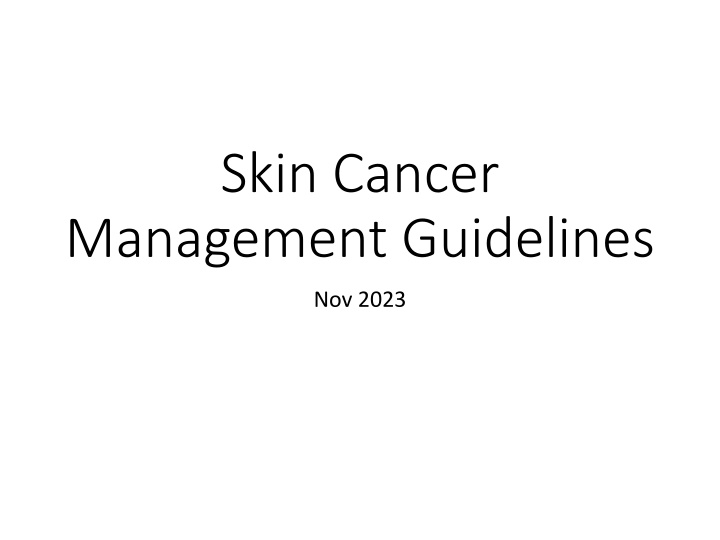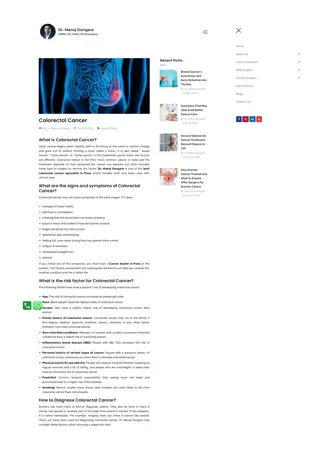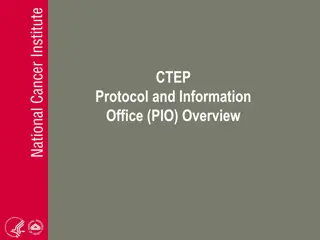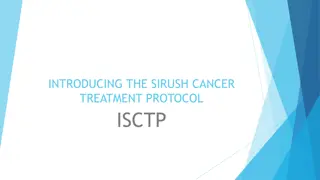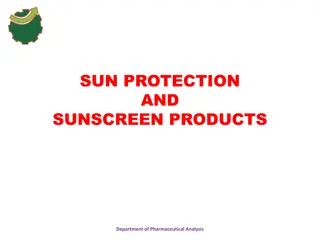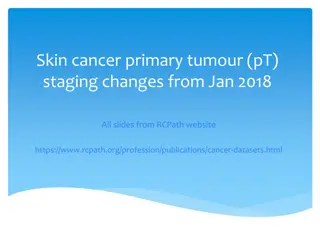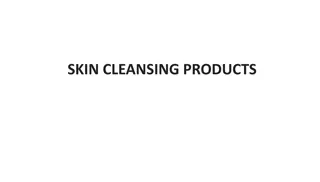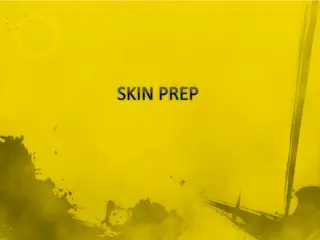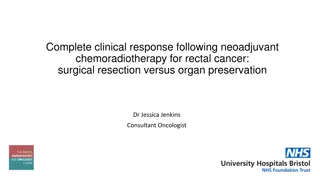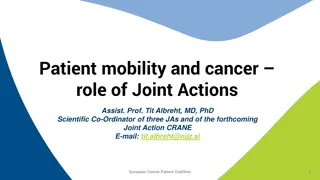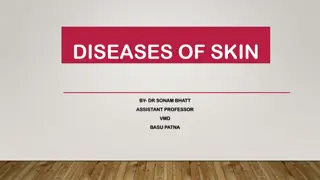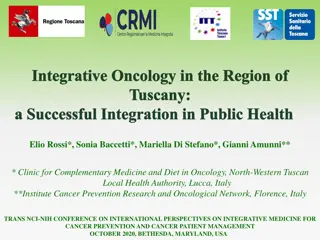Skin Cancer Management Guidelines - Surgical Approach and Follow-Up Protocol
Guidelines for managing suspicious pigmented lesions and invasive melanoma, with detailed protocols for excision margins, lymph node biopsy, staging scans, and follow-up care. Emphasis on surgical management, sentinel lymph node biopsy, medical oncology consultation, and shared follow-up with plastic surgery.
Download Presentation

Please find below an Image/Link to download the presentation.
The content on the website is provided AS IS for your information and personal use only. It may not be sold, licensed, or shared on other websites without obtaining consent from the author.If you encounter any issues during the download, it is possible that the publisher has removed the file from their server.
You are allowed to download the files provided on this website for personal or commercial use, subject to the condition that they are used lawfully. All files are the property of their respective owners.
The content on the website is provided AS IS for your information and personal use only. It may not be sold, licensed, or shared on other websites without obtaining consent from the author.
E N D
Presentation Transcript
Skin Cancer Management Guidelines Nov 2023
How to manage a suspicious pigmented lesion Excise with 2 mm margin Baseline photography of all suspected melanoma Return to clinic within 3 weeks with relative / friend Invasive Melanoma AJCC Stage IB or above* BT >1.0mm OR BT 0.8 - 1.0mm + ulceration / LVI / mitoses 2 Invasive Melanoma AJCC Stage IA BT <0.8mm + ulceration or 0.8 mm 1.0mm; no ulceration (pT1b) Invasive Melanoma AJCC Stage IA BT < 0.8 mm; no ulceration (pT1a) Melanoma insitu or lentigo maligna Aim to achieve 5 mm margin Re-excision to clear surgical plane 1 cm summated Margin Re-excision to fascia SSMDT case discussion Skin CNS review Refer to Plastics for SLNB If AJCC Stage IIB or above: Refer to oncology to consider adjuvant treatment Request staging scans: CT N/C/A/P & MRI Head Follow-up 5 years MDT list as per guidelines Review for suture removal Melanoma written info Arrange TBP images Self skin-surveillance advice Vit D supplementation MDT list as per guidelines Provide diagnosis and written info Arrange total body photography (TBP) Self skin-surveillance advice Vit D supplementation Discharge Follow-up: Yr 1 at 6 and 12 months: scar, lymph node & skin check. Yrs 2-5 annual F/U. Shared Care Guidelines with GP (if agreed) Follow-up at 6 and 12 months: scar, lymph node & skin check. Shared Care Guidelines with GP (if agreed)
*Surgical management of melanoma AJCC stage IB and above Breslow thickness >1mm or > 0.8mm with ulceration / LVI / mitoses >2 Offer sentinel lymph node biopsy at time of WLE -ve SLNB or SLNB not done +ve SLNB Arrange staging scans Request BRAF status Review in Specialist Skin MDT (SSMDT) Refer to Medical Oncology Discuss management immunotherapy +/- completion lymphadenectomy Stage IB & IIA Shared follow-up with Plastic Surgery and GP (if agreed) Yr 1&2: 3 mthly review; Yr 3: 6mthly and Yrs 4&5: yrly Stage IIB and above Baseline staging scans* & BRAF status Shared follow-up with Plastic Surgery & Medical Oncology - 3/12 reviews for 5 years Completion lymphadenectomy performed Yes Excision margins No Non-Head & Neck Breslow <1 mm 1-2 mm >2 mm Head & Neck Staging scans*: 6/12 for first 3 years 12/12 for 4th/5th years Staging scans*: 6/12 for first 3 years 12/12 for 4th / 5th years Consider USS of basin 6/12 for 3yrs Margin 1 cm 1-2 cm 2-3 cm 1cm margin, respecting anatomical structures Management of local recurrence or in-transit mets (Re)staging scan* Check BRAF status (request if not already done) SSMDT case discussion Combined Med Oncology / Plastic Surgery review Shared follow-up Plastic Surgery & Med Oncology Yrs 1-3 3/12 reviews; Yrs 4&5 6 monthly *Staging scans: CT neck, chest, abdo & pelvis + MRI Head with contrast
Melanoma surveillance AJCC stage I - III AJCC 8th Stage Clinical surveillance Imaging* CT N/C/A/P & MRI head; consider USS if SLNB not done Year 1 Year 2 Year 3 Year 4 Year 5 M3 M6 M9 M12 M15 M18 M21 M24 M30 M36 M42 M48 M54 M60 * * * * * * IA * * * * * * * * * * * * * * * IB * * * IIA * * * * * * * * * * * * IIB IIC IIIA/B/C IIID Stage IB / IIA can be shared surveillance with GP if agreed
HOW TO MANAGE BASAL CELL CARCINOMA OF THE SKIN IDENTIFY HIGH RISK TUMOURS Occurring on eyelids, nose, lips, ears. Immunosuppressed; tumours 2 cm diameter, ill-defined, infiltrative, micronodular, basosquamous, perineural invasion, recurrent or incompletely excised MANAGEMENT OF HIGH RISK TYPES MANAGEMENT OF LOW RISK TYPES EXCISION to clear deep surgical plane & 4 mm margin (If tumours 2 cm diameter or morphoeic / recurrent tumours then 6 mm margin), limited by local anatomy MOHS MICROGRAPHIC SURGERY should be considered if high risk tumour &/or critical site RADIOTHERAPY if surgical resection not suitable / margins inadequate & further surgery not possible CURETTAGE & CAUTERY consider for small nodular lesions or for palliation (3 cycles) CRYOTHERAPY - avoid except small nodular lesions (Two x 30 sec freeze thaw cycles) TOPICAL THERAPY (Aldara, PDT etc) - avoid except for superficial disease (thickness <2mm) EXCISION to clear deep surgical plane & 4mm margin CURETTAGE & CAUTERY useful in small / superficial tumours, caution in lower limbs. CRYOTHERAPY useful in small & superficial tumours, caution in lower legs. TOPICAL THERAPY (Aldara, PDT etc) helpful for small nodular & superficial disease (thickness <2mm) RADIOTHERAPY if surgery not appropriate MOHS rarely appropriate DISCHARGE MANAGEMENT OF INCOMPLETE EXCISION: MDT case discussion. Tumours incompletely excised at deep margins should be managed as high-risk tumours; incomplete peripheral margins in low-risk types can be less treated aggressively. FOLLOW UP: Patients with multiple tumours (inc Gorlins), complex repairs or close excision margins (<1mm) may benefit from more regular review but tailor follow up to individual risk. Advise all patients regarding photoprotection, skin self-surveillance.
HOW TO MANAGE SQUAMOUS CELL CARCINOMA OF THE SKIN ANY SINGLE FACTOR DENOTES HIGH RISK & ONE INVOLVED / CLOSE MARGIN (<1mm) UPSTAGES HIGH RISK SCC Tumour diameter > 2cm in diameter (pT2) Clinical: Lip / Ear / Arising in scar / ulcer. Immunosuppressed, CLL Pathology: > 4mm thickness. Clarks level V (subcut fat). Poorly differentiated. Perineural invasion (dermal, nerve diameter <0.1mm). Lymphovascular invasion. VERY HIGH RISK SCC Tumour diameter > 4cm (pT3). Thickness > 6mm; bone invasion. PNI in named nerve, beyond dermis (or >0.1mm). High grade subtype adenosquamous, desmoplastic, spindle/sarcomatoid MANAGEMENT OF HIGH RISK SCC MANAGEMENT OF LOW RISK SCC EXCISIONto clear deep surgical plane & 6 mm margin CURETTAGE & CAUTERY avoid except for palliation RADIOTHERAPY consider adjuvant treatment for PNI & primary RT for patients that will not have / tolerate surgery MOHS consider in recurrence & where margins may be technically difficult to achieve or are indistinct EXCISION to clear deep surgical plane & 4 mm margin CURETTAGE & CAUTERY useful in small (< 1cm) & superficial tumours particularly in early (in situ) disease. If subcutis involved manage as high risk CRYOTHERAPY useful in small (<1cm) & superficial tumours / early disease RADIOTHERAPY can be used as primary treatment especially in frail or elderly FOLLOW UP Check scar, draining LN & full skin exam. HIGH RISK: MDT case discussion if close / involved margins. Review 4mthly for 12 mths, 6 mthly for year 2 (can be shared care) VERY HIGH RISK: All cases for MDT case discussion Review 4 mthly for 2 yrs and 6mthly for year 3 (shared care). Immunosuppressed should be reviewed in dedicated transplant / immunosuppressed Derm clinics where possible MDT list as per guidelines SCC, photoprotection and self skin surveillance information Discharge:40% risk of further SCC/BCC in 5 yrs RECURRENCE Local recurrence (skin) - manage as per high risk tumours, consider MOHS Regional recurrence (nodal) - histological confirmation by FNA, request staging scans & refer to Plastics Consider immunotherapy for unresectable disease MDT case discussion
HOW TO MANAGE RECURRENT / METASTATIC SQUAMOUS CELL CARCINOMA OF THE SKIN DIAGNOSTIC BIOPSY PROVEN All cases should be discussed at an SSMDT Is there a palpable lymph node NO YES Request urgent FNA / biopsy AND Request staging CT scan neck / chest / abdo / pelvis, [MRI head if specific concerns] Consider combined oncology / plastic surgery opinion to consider surgical / radiotherapy and immunotherapy options e.g. cemiplimab LOCALLY RECURRENT DISEASE Consider imaging if appropriate Consider all therapeutic options surgery / MOHS radiotherapy immunotherapy e.g. cemiplimab FOLLOW UP Check scar, draining LN and full skin exam 5 yrs at 4 6 monthly intervals (shared care if available)
HOW TO MANAGE LOCALLY ADVANCED SQUAMOUS CELL CARCINOMA OF THE SKIN DISCUSSION AT SPECIALIST SKIN MDT With results of staging CT neck & CAP +/- MRI and biopsy Is the disease resectable*? POSSIBLY NO YES Proceed with surgery Adjuvant radiotherapy if indicated (close / positive margins, nodal disease, PNI, T4) Proceed with cemiplimab (and / or radiotherapy) Consider rediscussion at MDT regarding surgery if disease becomes resectable Multi-disciplinary discussion with patient about all therapeutic options * Definition of unresectable = at this point in time, the risks / consequences of surgery mean that resection is not preferred treatment modality. Tumour may be unresectable due to surgical / patient factors, or because after joint discussion with the patient the consequences of surgery mean that non-surgical options are preferable Resectability is not just a technical consideration and is not a final decision. Resectability can be reviewed at later timepoints even if patients initially opt for a non- surgical approach. Consider joint surgical / oncology reviews in cases of: Complex primary surgery Re-resection Is there a window of 9-12 weeks to consider an alternative to surgery
HOW TO MANAGE DERMATOFIBROSARCOMA PROTUBERANS (DFSP) DIAGNOSTIC BIOPSY PROVEN All cases should be discussed at an SSMDT MANAGEMENT OF DFSP MANAGEMENT OF DFSP with fibrosarcomatous change MOHS is preferable (in particular for all head, neck and groin sites, sites where margins may be technically difficult to achieve or are indistinctand recurrent cases) WIDE LOCAL EXCISION can be used for low-risk sites to clear deep surgical plane & 3 cm clinical margin MRI may be useful for investigating disease extent and subtype Aim to achieve complete histological clearance >1mm peripheral and deep margins Refer to sarcoma team FOLLOW UP Check scar, draining LN and full skin exam 3 yrs at 4 6 monthly intervals (shared care if available) RECURRENCE Local recurrence (skin) should be referred for MOHS
HOW TO MANAGE CUTANEOUS SARCOMA OF THE SKIN DIAGNOSTIC BIOPSY PROVEN MANAGEMENT OF ATYPICAL FIBROXANTHOMA (AFX) MANAGEMENT OF PLEIOMORPHIC DERMAL SARCOMA EXCISION of lesion to clear deep surgical plane & 5 10mm clinical margin Aim to achieve complete histological clearance >1mm peripheral and deep margins EXCISION of lesions to clear deep surgical plane & 10 mm clinical margin Aim to achieve complete histological clearance >1mm peripheral and deep margins MDT LIST AS PER GUIDELINES Self skin surveillance information DISCHARGE FOLLOW UP Check scar, draining LN and full skin exam. 2 yrs at 4 6 monthly intervals (shared care if available). MDT list as per guidelines unless incomplete or histology requires review RECURRENCE Local recurrence (skin) must be discussed at SSMDT
HOW TO MANAGE LEIOMYOSARCOMA OF THE SKIN DIAGNOSTIC BIOPSY-PROVEN / EXCISION OF LESION MANAGEMENT OF DERMAL LEIOMYOSARCOMA MANAGEMENT OF SUBCUTANEOUS TYPE WIDE LOCAL EXCISION to clear deep surgical plane & 1cm peripheral margin Refer to sarcoma team Aim to achieve complete histological clearance >1mm peripheral and deep margins FOLLOW UP Check scar, draining LN and full skin exam. Shared care for 2 yrs at 6 monthly intervals All cases should be discussed at an MDT RECURRENCE Local recurrence must be discussed at SSMDT
HOW TO MANAGE POROCARCINOMA OF THE SKIN DIAGNOSTIC BIOPSY-PROVEN MANAGEMENT OF POROCARCINOMA EXCISION to clear deep surgical plane & 4 mm margin MOHSMICROGRAPHIC SURGERY consider in recurrent cases & where margins are indistinct or may be technically difficult to achieve Complete histological clearance >1mm peripheral and deep margins FOLLOW UP Check scar, draining LN and full skin exam. 2 yrs at 6 monthly intervals (shared care). MDT list as per guidelines unless close / involved margins or histology requires review RECURRENCE Local recurrence must be discussed at SSMDT
HOW TO MANAGE MERKEL CELL CARCINOMA OF THE SKIN DIAGNOSTIC BIOPSY PROVEN Is there a palpable lymph node NO YES Request whole body PET-CT scan Urgent referral to a specialist combined clinical oncology / plastic surgery clinic with expertise in managing Merkel cell carcinoma List for discussion at next SSMDT Request urgent FNA AND Request whole body PET-CT scan Urgent referral to a specialist combined clinical oncology / plastic surgery clinic with expertise in managing Merkel cell carcinoma List for discussion at next SSMDT These patients benefit from multidisciplinary care and so consider referral to tertiary centre. Arrange investigations simultaneously to avoid delay
